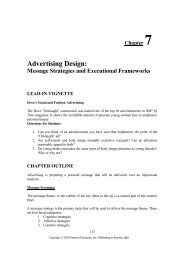I n t e r n a t i o n a l M a r k e t i n g
I n t e r n a t i o n a l M a r k e t i n g
I n t e r n a t i o n a l M a r k e t i n g
You also want an ePaper? Increase the reach of your titles
YUMPU automatically turns print PDFs into web optimized ePapers that Google loves.
I n t e r n a t i o n a l M a r k e t i n g1 4 t h E d i t i o nP h i l i p R. C a t e o r aM a r y C. G i l l yJ o h n L . G r a h a mCulture,Management Style,andBusiness SystemsChapter 5McGraw-Hill/IrwinInternational Marketing 14/eCopyright © 2009 by The McGraw-Hill Companies, Inc. All rights reserved.
What Should You Learn?• The necessity for adapting to cultural differences• How and why management styles vary aroundthe world• The extent and implications of gender bias inother countries• The importance of cultural differences inbusiness ethics• The differences between relationship-orientedand information-oriented cultures5-2
Global PerspectiveDo Blondes Have More Fun in Japan?• Culture, including all its elements, profoundlyaffects management style and overall businesssystems– Max Weber (1930)• Americans– Individualists• Japanese– Consensus oriented & committed to the group• Central & Southern Europeans– Elitists and rank conscious5-3
Global PerspectiveDo Blondes Have More Fun in Japan?• Knowledge of the management style existing ina country and a willingness to accommodate thedifferences are important to success in aninternational market– Business culture– Management values– Business methods– Behaviors5-4
Required Adaptation• Adaptation is a key concept in internationalmarketing• Ten basic criteria for adaptation1) open tolerance2) flexibility3) humility4) justice/fairness5) ability to adjust to varying tempos6) curiosity/interest7) knowledge of the country8) liking for others9) ability to command respect10) ability to integrate oneself into the environment5-5
Degree of Adaptation• Essential to effective adaptation– Awareness of one’s own culture and the– Recognition that differences in others can cause anxiety,frustration, and misunderstanding of the host’s intentions• The self-reference criterion (SRC) is especiallyoperative in business customs• The key to adaptation is to remain American butto develop an understanding of and willingnessto accommodate the differences that exist5-6
Imperatives, Electives,and Exclusives• Cultural imperatives– Business customs and expectations that must be met and conformed toor avoided if relationships are to be successful► The significance friendship cannot be overemphasized– In some cultures a person’s demeanor is more critical than in others– Imperatives vary from culture to culture• Cultural electives– Relate to areas of behavior or to customs that cultural aliens may wishto conform to or participate in but that are not required– A cultural elective in one county may be an imperative in another– Cultural electives are most visibly different customs• Cultural exclusives– Customs or behavior patterns reserved exclusively for the locals5-7
The Impact of American Cultureon Management Style• “Master of destiny” viewpoint• Independent enterprise as the instrument ofsocial action• Personnel selection and reward based on merit• Decisions based on objective analysis• Wide sharing in decision making• Never-ending quest for improvement• Competition producing efficiency5-8
Authority and Decision Making• Influencers of the authority structure of business:– High PDI Countries► Mexico, Malaysia– Low PDI Countries► Denmark, Israel• Three typical authority patterns:– Top-level management decisions– Decentralized decisions– Committee or group decisions5-9
Management Objectivesand Aspirations• Security and mobility– Relate directly to basic human motivation and therefore havewidespread economic and social implications• Personal life– Worldwide study of individual aspirations, (David McClelland)• Affiliation and social acceptance– In some countries, acceptance by neighbors and fellow workersappears to be a predominant goal within business• Power and achievement– South American countries5-10
Annual Hours WorkedExhibit 5.15-11
Communication Styles• Face-to-face communication– Managers often fail to develop even a basic understanding of just oneother language– Much business communication depends on implicit messages that arenot verbalized• Internet communications– Nothing about the Web will change the extent to which people identifywith their own language and cultures► 78% of today’s Web site content is written in English► An English e-mail message cannot be understood by 35% of all Internet users– Country-specific Web sites– Web site should be examined for any symbols, icons, and othernonverbal impressions that could convey and unwanted message5-12
Formality and Tempo• Breezy informality and haste characterize Americanbusiness relationships• Europeans not necessarily “Americanized”• Higher on Hofstede’s Power Distance Index (PDI)– May lead to business misunderstandings• Haste and impatience most common mistakes– Middle East• For maximum success marketers must deal with foreignexecutives in acceptable ways– Developing friendships5-13
Contextual Backgroundof Various CountriesExhibit 5.25-14
P-Time versus M-Time• Monochronic time– Tend to concentrate on one thing at a time– Divide time into small units and are concerned with promptness– Most low-context cultures operate on M-Time• Polychronic time– Dominant in high-context cultures– Characterized by the simultaneous occurrence of many things– Allows for relationships to build and context to be absorbed as parts of highcontextcultures• Most cultures offer a mix of P-time and M-time behavior– Have a tendency to be either more P-time or M-time in regard to the roletime plays• As global markets expand more businesspeople fromP-time cultures are adapting to M-time.5-15
Speed is RelativeExhibit 5.35-16
Negotiations Emphasis• Business negotiations are perhaps the mostfundamental business rituals• The basic elements of business negotiations arethe same in any country– They relate to the product, its price and terms, servicesassociated with the product, and finally, friendship betweenvendors and customers• One standard rule in negotiating is “knowthyself” first, and second, “know yourcounterpart”5-17
Marketing Orientation• A company’s marketing orientation has beenpositively related to profits (U.S.)• Other countries have more traditional approach– Production orientation (consumers will prefer products that arewidely available)– Product orientation (consumers will favor products that offer themost quality performance, or innovative features)– Selling orientation (consumers and businesses alike will not buyenough without prodding)• Encouraging a marketing orientation acrossglobal business units can be difficult5-18
Gender Biasin International Business• Women represent only 18% of the employees who arechosen for international assignments• In many cultures women not typically found in upperlevels of management, and are treated very differentlyfrom men– Asia, Middle East, Latin America• Prejudices toward women in foreign countries• Cross-mentoring system– Lufthansa• Executives who have had international experience– More likely to get promoted,– Have higher rewards, and have– Greater occupational tenure5-19
Few and Far Between – FemaleDirectors on Corporate BoardsExhibit 5.45-20
Corruption Defined• Types of Corruption– Profits (Marxism)– Individualism (Japan)– Rampant consumerism (India)– Missionaries (China)– Intellectual property laws (Sub-Sahara Africa)– Currency speculation ( Southeast Asia)• Criticisms of Mattel and Barbie– Sales of Barbie declined worldwide after the global standardization– Parents and government did react– Mattel’s strategy boosted sales of its competition5-21
The Western Focus on Bribery• 1970s, bribery became a national issue with publicdisclosure of political payoffs to foreign recipients byU.S. firms• The decision to pay a bribe creates a major conflictbetween what is ethical and proper and what isprofitable and sometimes necessary for business• OECD Convention on combating the bribery offoreign public officials in international businesstransactions• Transparency International (TI)5-22
Transparency InternationalCorruption Perception IndexExhibit 5.55-23
Exhibit 5.6Transparency InternationalBribe Payer’s Index5-24
Bribery –Variations on a Theme• Bribery and Extortion– Voluntary offered payment by someone seeking unlawful advantage isbribery– If payments are extracted under duress by someone in authority from aperson seeking only what he are she is lawfully entitled to that isextortion• Subornation and Lubrication– Lubrication involves a relatively small sum of cash, a gift, or a servicegiven to a low-ranking official in a country where such offerings are notprohibited by law– Subornation involves giving large sums of money, frequently notproperly accounted for, designed to entice an official to commit an illegalact on behalf of the one offering the bribe5-25
• Agent’s FeesBribery –Variations on a Theme– When a businessperson is uncertain of a country’s rulesand regulations, an agent may be hired to represent thecompany in that country– The Foreign Corrupt Practices Act– Change will come only from more ethically and sociallyresponsible decisions by both buyers and sellers and bygovernments willing to take a stand5-26
Ethical and SociallyResponsible Decisions• Difficulties arise in making decisions, establishing policies, andengaging in business operations in five broad areas– Employment practices and policies– Consumer protection– Environmental protection– Political payments and involvement in political affairs of the country– Basic human rights and fundamental freedoms• Laws are the markers of past behavior that society has deemedunethical or socially irresponsible• Ethical principles to help the marketer distinguish between rightand wrong, determine what ought to be done, and justify actions– Utilitarian Ethics– Rights of the Parties– Justice or Fairness5-27
• British-AmericanCulture’s Influenceon Strategic Thinking– Individualistic• Japan & Germany– Communitarian• In the less individualistic cultures labor and managementcooperate• A competitive, individualistic approach works well in thecontext of an economic boom• Fourth kind of capitalism –– Common in Chinese cultures– Predicted by culture5-28
A Synthesis – Relationship-Orientedvs. Information-Oriented Cultures• Studies are noting a strong relationship between Hall’shigh/low context and Hofstede’s Individualism/Collectiveand Power Distance indexes• Not every culture fits every dimension of culture in aprecise way• Information-oriented culture– United States• Relationship culture– Japan• Synthesis of cultural differences allows us to makepredictions about unfamiliar cultures5-29
Dimensions of Culture, A SynthesisExhibit 5.75-30
Summary• Some cultures appear to emphasize the importance ofinformation and competition while others focus more onrelationships and transaction cost reductions• Businesspersons working in another country must besensitive to the business environment and must bewilling to adapt when necessary• Understanding the culture you are entering is the onlysound basis for planning• Business behavior is derived in large part from the basiccultural environment in which the business operates and,as such, is subject to the extreme diversity encounteredamong various cultures and subcultures5-31
Summary• Environmental considerations significantly affect theattitudes, behavior, and outlook of foreignbusinesspeople• Varying motivational patterns inevitably affect methodsof doing business in different countries• The international trader must be constantly alert andprepared to adapt when necessary• No matter how long in a country, the outsider is not alocal – in many countries that person may always betreated as an outsider• Assuming that knowledge of one culture will provideacceptability in another is a critical mistake5-32









